WAS SEPTEMBER 11TH ATTACK TOTALLY UNEXPECTED?
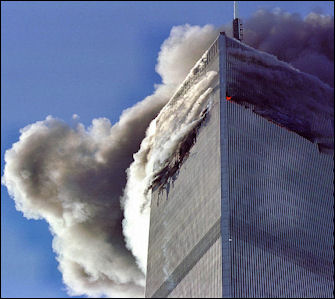
World Trade Center crash On whether the September 11 attack was unimaginable as many people said, Brian Michael Jenkins wrote in the Washington Post: “In 2002, the White House described 9/11 as “a new type of attack that had not been foreseen.” An understandable response to being caught off guard, perhaps — but the fact is that the possibility of hijacked airliners crashing into buildings was neither unimaginable nor unimagined. The idea dates at least to 1972, when hijackers, during a protracted domestic incident, shot the co-pilot of a Southern Airways flight and threatened to crash the plane into the nuclear facility at Oak Ridge, Tenn. [Source: Brian Michael Jenkins, Washington Post, September 2, 2011; Jenkins is a senior adviser to the president of the Rand Corporation and is co-editor of “The Long Shadow of 9/11: America’s Response to Terrorism”]
“After the 1993 bombing at the World Trade Center, a “red team” of consultants (myself included) hired by the center to explore future threats to the site identified a plane crashing into one of the towers as a possible scenario. In 1994, hijackers of an Air France jet reportedly considered crashing the aircraft into the Eiffel Tower. And a terrorist plot discovered in 1995 involving Ramzi Yousef, one of the 1993 World Trade Center bombers, and Khalid Sheik Mohammed, the self-described architect of 9/11, contemplated crashing an explosives-laden plane into the headquarters of the CIA.
“Nonetheless, the 9/11 attacks transformed our perceptions of plausibility. Terrorist scenarios deemed far-fetched on Sept. 10, 2001, became operative presumptions one day later; even a 1 percent chance of something happening was sufficient cause to treat the possibility seriously. This skepticism-free environment multiplied public fears and security spending. Meanwhile, terrorists carried out more predictable low-tech attacks on commuter trains and subways.
See Separate Article KHALID SHEIK MOHAMMED: 9/11, TERRORIST PLOTS AND RAMZI YOUSEF factsanddetails.com
September 11th-Style Attack in Turkey in 1998
Carl Vick wrote in the Washington Post: “The plan was to fly a hijacked plane into a national landmark on live television. The year was 1998, the country was Turkey, and the rented plane ended up grounded by weather. Court records show the Islamic extremist who planned to commandeer the cockpit did not actually know how to fly.”
“But if the audacious scheme prefigured Sept. 11, 2001, it also highlighted a cause that, seven years later, President Bush has used to define the war against terrorism. What the ill-prepared Turkish plotters told investigators they aimed to do was strike a dramatic blow toward reviving Islam's caliphate, the institution that had nominally governed the world's Muslims for nearly all of the almost 1,400 years since the death of the prophet Muhammad. [Source: Carl Vick, Washington Post, January 14, 2006]
Osama Bin Laden’s Fatwas to Kill Americans
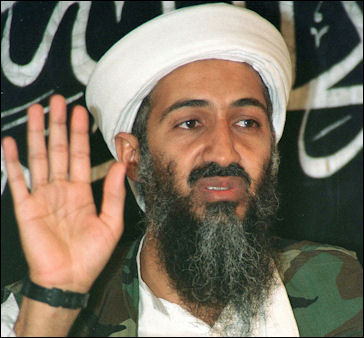
On February 23, 1996, Osama bin Laden issued a “declaration of war” fatwa in which Muslims were called upon to expand jihad to America and kill American soldiers and remove Americans from the Arabia peninsula. “The walls of oppression and humiliation,” said the fatwa, “cannot be demolished except in a rain of bullets.”
On February 28, 1998, Osama bin Laden issued his most violent fatwa in which expanded his jihad to include American civilians and said it was the duty of Muslims to kill Americans wherever they may be found. He said it is “the individual duty” of every Muslim “to kill the Americans and their allies — civilians, military in any country in which it is possible.” He justified the fatwa with the following quote from the Koran: “So when the sacred months have passed away, then slay the idolaters wherever you find them, and take captives and besiege them and lie in wait for them in every ambush.”
Osama bin Laden has attempted to convince the world’s 1 billion plus Muslims that they are engaged in a religious war against the Western Christian world. He likes to refer to the American and Westerners as Crusaders and characterize his struggle as a battle between Christians and Muslims. He has blamed the West for destroying the great Muslim cities in Spain and declared “jihad against Crusaders and Jews.” Many Muslim do this day look upon the Crusader period as an era of injustice and humiliation.
When Osama bin Laden declared “war” on the United States in 1998 he called Americans “the most filthy human beings” and a “lowly people.” He also said: “It is our duty to make Jihad so that God’s word is the one exalted to the height and so that we drive the Americans away from all Muslim countries.” “In our religion its not permissible for any non-Muslims to stay in our country. If the Americans refuse to listen...then be aware you will lose this Crusade, just like the previous Crusades in which you were humiliated.” He also said, "Get rid of all the Americans and all of the Jews out of the land of Islam,” which presumably includes Israel.
Osama bin Laden and the United States
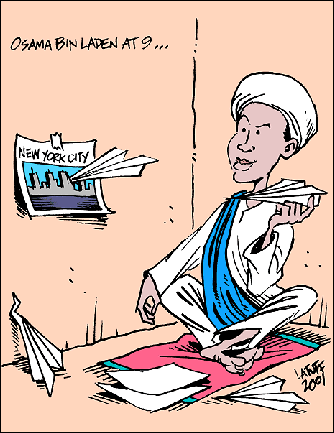
Osama bin Laden at nine Osama bin Laden August 1996 "Declaration of War Against the Americans Occupying the Land of the Two Holy Places" edict read: “Muslims burn with anger at America,” it read. The presence of American forces in the Persian Gulf states “will provoke the people of the country and induces aggression on their religion, feelings, and prides and pushes them to take up armed struggle against the invaders occupying the land.” The imbalance of power between American forces and Muslim forces demanded a new kind of fighting, he wrote, “in other words, to initiate a guerrilla war, where sons of the nation, not the military forces, take part in it.” [Source: Kate Zernike and Michael T. Kaufman, New York Times, May 2, 2011]
In this lengthy statement, published in the London newspaper Al-Quds al-Arabi, bin Laden boldly lays out his case against the Saudi ruling family and its American backers. "Everyone agrees that the shadow of a stick cannot be straightened as long as the stick is crooked," he writes. "Hence, it is imperative to focus on attacking the main enemy." He argues that the West deliberately divided the Muslim world into "states and mini-states," which could be easily controlled. He declares, "There is no higher priority, after faith, than pushing back the American-Israeli alliance." He calls upon all Muslims to participate in jihad in order to liberate Saudi Arabia and restore the dignity of the Islamic community. "In view of the enemy's strength, fast and light forces must be used and must operate in absolute secrecy."[Source: Lawrence Wright, The New Yorker, September 16, 2002]
The United States and its allies did not remove its troops from the Persian Gulf region. “So we tell the Americans as a people,” Osama bin Laden told ABC News, “and we tell the mothers of soldiers and American mothers in general that if they value their lives and the lives of their children, to find a nationalistic government that will look after their interests and not the interests of the Jews. The continuation of tyranny will bring the fight to America, as Ramzi Yousef and others did. This is my message to the American people: to look for a serious government that looks out for their interests and does not attack others, their lands or their honor.” [Source: Kate Zernike and Michael T. Kaufman, New York Times, May 2, 2011]
After the United States retaliated with missile strikes in Afghanistan after American embassy attacks in Kenya and Tanzania, bin Laden said: “To call us Enemy No. 1 or Enemy No. 2 does not hurt us, “Osama bin Laden is confident that the Islamic nation will carry out its duty.” "We believe that the biggest thieves in the world and the terrorists are the Americans," Bin Laden said in a February 1999 magazine interview. "The only way for us to fend off these assaults is to use similar means. We do not worry about American opinion or the fact that they place prices on our heads."
Americans have fought on the side of Muslims in Bosnia, Somalia, Afghanistan and other places.
Murder of Rabbi Meir Kahane in 1990
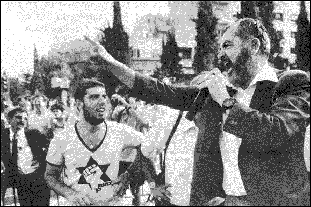
Rabbi Kahane Daniel Byman wrote in the Washington Post: One of the first Sunni-jihadist-linked attacks in the United States was the 1990 murder of extremist rabbi Meir Kahane, who founded the Jewish Defense League. El Sayyid Nosair was charged with the murder, but the attack was treated as a simple crime, and Nosair escaped conviction. He went on to try to kill thousands of people as part of the 1993 attempt to bomb World Trade Center. [Source: Daniel Byman, Washington Post, January 14, 2011]
“An obscure Saudi named Osama bin Laden helped pay for Nosair's legal defense in the Kahane trial, but the narrow focus on the crime led prosecutors to ignore the broader conspiracy of which the defendant was a part. Nosair was later convicted in the World Trade Center bombing on charges that included "seditious conspiracy" and racketeering, legal tools that prosecutors have used to go after terrorists. The conspiracy in this case included the Kahane murder. It was only after terrorism came into play that Nosair met justice.
Attack on the World Trade Center in 1993 and Ramzi Yousef
On February 26, 1993, a 1,500-pound bomb planted in a van blew up in the underground garage of the World Trade Center in New York. Six people were killed and more than 1,000 were injured. The blast caused major damage to the building's foundations; some 55,000 people were working in the towers at the time. The terrorists had hoped to topple the skyscraper and release cyanide gas packed in a nearby truck. The cyanide was harmlessly burned up in the explosion.
Investigators determined that the cell built the bomb in New Jersey by consulting manuals brought from Pakistan. Some of the plotters acted foolishly. One of them went back to get his security deposit on the truck used in the bombing. Some of the plotters had links to Shiek Omar Abdel-Rahamn, the Blind Sheik who lashed out against Americans from his mosque in New Jersey.

Ramzi YousefRamzi Yousef, the mastermind of the 1993 attack on the World Trade Center, used Manila as a base for his plans and also worked out of Pakistan. He is the nephew of Khalid Shailkh Mohammed, an ethnic Pakistani born and raised in Kuwait and by some accounts was the number three man in Al-Qaida and the organizer of many of its activities before he was captured in Pakistan in March 2003.
Yousef had links with Al-Qaida but was regarded as a freelancer. Even so he is credited with making Al-Qaida a worldwide terrorist network. He hatched a plan to fly planes full of explosives in the CIA building and nuclear power plants. Some regard these as blueprints for the attack on the World Trade Center in New York on September 11, 2001. Many believe that if the CIA and the FBI took this plot more seriously September 11th could have been avoided.
Yousef was captured in Pakistan in February 1995 with a tip from an informer who was given a $2 million reward. A search a month earlier in a Philippines apartment, where Yousef stayed with his Filipina girlfriend, enabled police to discover his computer which contained files of some of his plots, as well as some bomb-making equipment. The search took place after one of Yousef’s cohorts, Abdul Hakim Murad, started a fire while mixing water with explosive chemicals in his sink. The computer files led to the arrest of 27 foreign terror suspects, including Adel Anonn, the owner of a Mindanao Meat Shop in Manila, and Yousef’s twin brother.
After Yousef was arrested in Pakistan he was quickly extradited to the United States. After he arrived in New York, FBI agents drove him by the World Trade Center and said, "See, it's still standing." He reportedly said, "If I had a little more money, it wouldn't be." Two Americans were killed soon after the extradition in what was believed to be a revenge killing. Yousef was tried and convicted in the United States and was sentenced to life in prison for masterminding the 1993 World Trade Center bombing. After the sentencing he said, "Yes, I am a terrorist and proud of it." He is now serving a life sentence at a prison in Colorado.
See Separate Article KHALID SHEIK MOHAMMED: 9/11, TERRORIST PLOTS AND RAMZI YOUSEF factsanddetails.com
Background Behind the Attack on the World Trade Center in 1993
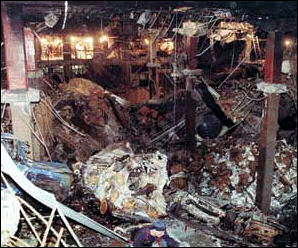
World Trade Center damage On the background behind the 1993 World Trade Center attack, Terry McDermott wrote in The New Yorker: In 1991, Abdul Basit Mahmud Abdul Karim [Ramzi Yousef] “got in touch with Abdul Hakim Murad, a fellow-Baluchi and a boyhood friend from Kuwait, who was then in the U.S., training as a pilot. Basit told him that he wanted to attack Israel, but thought it too difficult. He would attack America instead. He asked Murad to suggest potential Jewish targets in the United States, and Murad agreed to think about it. After Murad finished his training and returned to the Gulf, in 1992, Basit got in touch again and asked if he had identified a target. [Source: Terry McDermott, The New Yorker, September 13, 2010]
“I told him the World Trade Center,” Murad later told investigators. “He asked me why, and I gave him the reasons. I asked him what he was going to do. He told me that he took training for six months in Afghanistan. I asked him what kind of training. So he told me, “Chocolate.” I answered, “What do you mean by chocolate?” He said, “Boom.” And I immediately understood that he took training in explosives, and he told me it is time to go to the United States.”
Why the United States? Murad said, “I was working for my religion, because I feel that my Muslim brothers in Palestine are suffering. Muslims in Bosnia are suffering, everywhere they are suffering. And, if you check the reason for the suffering, you will find that the U.S. is the reason for this. If you ask anybody, even if you ask children, they will tell you that the U.S. is supporting Israel, and Israel is killing our Muslim brothers in Palestine. The United States is acting like a terrorist, but nobody can see that.”
“In the fall of 1992,” McDermott wrote, “Basit, accompanied by a man he had recruited, bought a first-class ticket from Karachi to New York City. His passport identified him as an Iraqi named Ramzi Yousef. He had no entry visa; when questioned at immigration, he admitted that the I.D. was fake. He asked for political asylum and eventually was freed on his own recognizance, to await a hearing. Basit quickly made acquaintances through a mosque in Jersey City and recruited men to join him in a plan to bomb the World Trade Center. The attack was a ramshackle, small-scale affair. In just a few months, Basit designed and built a bomb that cost about three thousand dollars. Mohammed, still in the Gulf, conferred with him often by telephone and contributed six hundred and sixty dollars. He said later that he was inspired by the ease with which Basit operated in the United States. The bomb was stowed in a rented van and parked in the basement garage of the North Tower. Basit’s plan was that it would topple the North Tower into the South Tower, bringing them both to the ground. The bomb exploded on February 26, 1993, and although it was insufficient to the intended task, it caused millions of dollars in damage and killed six people. Basit had come upon his own notion of jihad: not just a war against states but a non-stop, all-out war on all enemies, anywhere they could be reached.
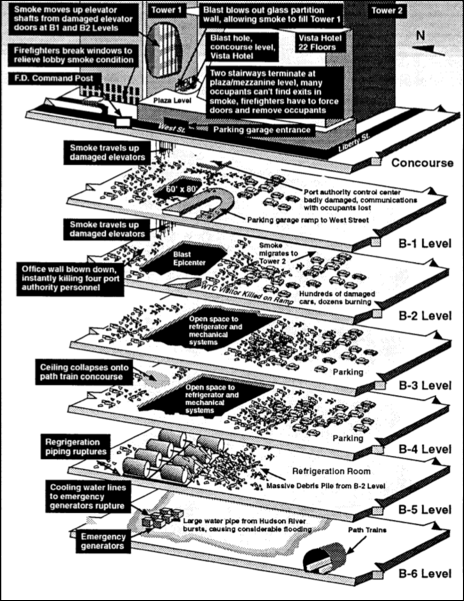
Plot to Blow Up a Dozen Airliners Over the Pacific
In the 1990s, Mohammed and Ramzi Yousef, plotted to blow up a dozen airliners vver the Pacific In the Book: “The Hunt for KSM”, Terry McDermott & Josh Meyer wrote: “The key ingredient in the prospective airplane bomb was nitromethane, which was inexpensive and readily available in the Philippines. Mohammed emptied the contents of fourteen contact lens solution bottles, taking care to not break the plastic seals on the bottles. He then refilled them with the nitro. He carried thirteen of the bottles in his carry-on bag on a flight to Seoul. . . . To test his ability to clear airport security while carrying a metal detonator, Mohammed carried a small metal bolt. He taped the bolt beneath the arch of his foot, then covered his foot with a sock. . . . He set off alarms at the security scanner and was asked to undress. This included his shoes, but not his socks, and he was passed through. He realized later that he had left a detailed plan for the attacks in his carry-on bag; it contained all twelve of the targeted flights as well as the time the bombs were intended to explode. Security officials didn’t notice the plan, but did ask why he was carrying so much contact lens solution. I found a great sale in Manila, he said.”
Raymond Bonner and Benjamin Weiser wrote in the New York Times: “That scheme was developed in Manila by Mohammed as he was starting his climb to become a top lieutenant to Osama bin Laden, and Ramzi Ahmed Yousef, who was a mastermind of the 1993 bombing of the World Trade Center. Philippine investigators came to believe that the Manila operation was financed by Mr. bin Laden... Mohammed code-named the operation Bojinka, which was widely reported to have been adopted from Serbo-Croatian, meaning big bang. But Mr. Mohammed has told his C.I.A. interrogators that it was just a “nonsense word” he adopted after hearing it when he was fighting in Afghanistan during the war against the Soviet Union, according to “The 9/11 Commission Report.” [Source: Raymond Bonner and Benjamin Weiser, New York Times, August 11, 2006]
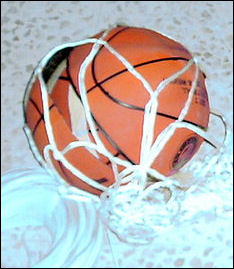
TATP bomb hidden in
a basketball
“At an apartment in Manila, Mr. Yousef began mixing chemicals, which he planned to put into containers that would be carried on board airliners, much like the plotters in a foiled attack in Britain in 2006 had been planning. “In those days, it would have been relatively easy to get liquid explosives past a checkpoint. Mr. Mohammed and Mr. Yousef, according to the 9/11 Commission, studied airline schedules and planned to sneak the liquid on a dozen planes headed to Seoul, South Korea, and Hong Kong and then on to the United States. The idea was that the bombs, complete with timing devices, would be left on the airliners, but that the plotters would disembark at a stop before detonating the devices.”
To rehearse the operations, a practice bomb was detonated in a Manila theater late in 1994. Another bomb was concealed aboard Philippine Airlines Flight 434 from Manila to Tokyo 10 days later. The bomb exploded on the way to Tokyo, killing a passenger, but the pilot managed to land the damaged 747. American prosecutors later concluded that Mr. Yousef had taken a liquid explosive onto the plane before disembarking.
Mr. Yousef was captured in Pakistan, turned over to the United States, convicted in New York and sentenced to life without parole. Mary Jo White, the former United States attorney whose office successfully investigated and prosecuted Mr. Yousef in the Bojinka plot, told the New York Times, “It was frightening. There were people wandering the globe able to do this. And that was 10 years ago.”
Book: “The Hunt for KSM: Inside the Pursuit and Takedown of the Real 9/11 Mastermind Khalid Sheikh Mohammed” by Terry McDermott & Josh Meyer (Little, Brown & Co., 2012)
Hatching the Plan to Blow Up a Dozen Airliners Over the Pacific
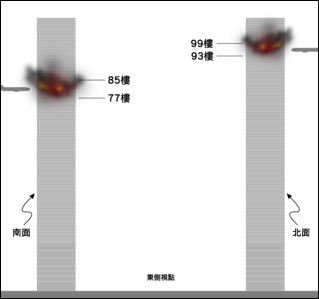
September 11th attack, floors
Terry McDermott wrote in The New Yorker: “In Karachi, Basit had introduced his pilot friend, Murad, to Mohammed giving Mohammed’s name as Abdul Majid — and Mohammed had quizzed him about pilot training and flying aircraft. They met again, at Mohammed’s apartment, then at a Karachi restaurant. Each time, Mohammed interrogated Murad about flying. Murad, the licensed pilot, at one point suggested to Basit dive-bombing a plane into C.I.A. headquarters. [Source: Terry McDermott, The New Yorker, September 13, 2010]
“Out of those conversations, Mohammed and Basit devised a plan. Basit thought that he could build electronically controlled bombs small enough to smuggle aboard airliners. The explosive would be formed by combining volatile liquids, which could be carried onto planes in small plastic bottles, such as those used for contact-lens solutions. For timers, he would use Casio Databank watches, which had programmable alarms. Because the watches could be set as much as a year in advance, Basit’s men could place the bombs on board aircraft and set them to explode on a future flight.
The plan was to deposit the bombs on airliners bound for the United States. According to files found on Basit’s laptop, he and Mohammed decided to have five men plant bombs on aircraft bound from Asia to the U.S.”a dozen jumbo jets in total, with at least three hundred people on each plane. They tested a small version of the device in a Manila movie theatre, and it worked, blowing up an empty seat. Not long afterward, they tried a slightly bigger one aboard a Philippine Airlines flight from Manila to Tokyo, with a stop on the Philippine island of Cebu. Basit boarded the flight in Manila, set the timer, and planted the device beneath a seat. Then he got off the plane in Cebu. The bomb went off as scheduled on the next leg of the flight, killing a Japanese businessman and nearly downing the aircraft, which managed to land with a hole in its fuselage.
Basit and Mohammed began their final preparations. They brought Murad in from the Gulf. He was not particularly surprised to see Basit’s apartment full of bomb-making materials — “chocolate” — but was very surprised to see Mohammed, whom he knew as a Pakistani businessman, at the Josefa. Mohammed wore gloves every time he visited, Murad told investigators, and no one but Basit knew his real name.
Plan to Blow Up a Dozen Airliners Over the Pacific Comes Apart
Raymond Bonner and Benjamin Weiser wrote in the New York Times: The plot, however, was foiled in early 1995 when a fire broke out in the apartment where some of the conspirators were working. Among the things found when the police investigated was Mr. Yousef’s laptop, with a file named “Bojinka.” They also found dolls with clothes containing nitrocellulose, according to the 9/11 Commission. “When the police hit the place, they were weeks away from starting,” said Michael J. Garcia, a prosecutor in the 1996 Bojinka trial and now the United States attorney in Manhattan. “In Ramzi’s laptop there were very detailed plans,” he said, including equipment, airports, flight numbers and the timer settings. [Source: Raymond Bonner and Benjamin Weiser, New York Times, August 11, 2006]

Terry McDermott wrote in The New Yorker: “The group lacked discipline. Just before New Year’s Day, Mohammed and Basit left Manila for a weekend, saying they were going scuba diving. Not long after Basit returned, he accidentally ignited a small chemical fire in the apartment, which led police to discover the bomb-making materials. It took two police vans to haul the evidence away: cotton batting, Bibles, cassocks, pipes, chemicals, a small case of condoms, watches. Murad told investigators that he and Basit had slept until noon that day and gone shopping at a mall in the afternoon before returning to build bombs. Murad was arrested the night of the fire, Basit a month afterward in Pakistan, and Shah later in Malaysia. The only one who got away was Khalid Sheikh Mohammed. [Source: Terry McDermott, The New Yorker, September 13, 2010]
Things Learned from the Plot to Blow Up a Dozen Airliners Over the Pacific
Raymond Bonner and Benjamin Weiser wrote in the New York Times: Mr. Mohammed has told his interrogators that after the 1993 World Trade Center bombing, which involved explosives loaded onto a truck that failed to bring down the building, he “needed to graduate to a more novel form of attack,” as the 9/11 report puts it. That led to Bojinka, and the first thoughts about using planes to bomb the World Trade Center. [Source: Raymond Bonner and Benjamin Weiser, New York Times, August 11, 2006]
According to investigators, Mr. Yousef’s specialty was making bombs from innocuous-looking objects that could be smuggled through airport security — a digital wristwatch modified to serve as a timer, or a plastic bottle for contact lens solution filled with liquid components for nitroglycerine. When questioned after his arrest, Mr. Yousef refused to explain precisely how he had planned to carry out the bombings, according to testimony at his trial for the Bojinka plot.
Brian G. Parr, a Secret Service agent, testified at the trial that under questioning Mr. Yousef made clear that other terrorists were aware of the explosive technique, and he did not want to compromise their ability to carry out similar acts. “He said that he didn’t want us to have knowledge of the techniques that they were going to use,” Mr. Parr testified, “because it may help us prevent other people from using those techniques.”
And Mr. Yousef, in his statement to Mr. Parr, made clear that he had carefully analyzed how to carry explosives through airline security. For example, when questioned about one chemical mixture that could be used in explosives, Mr. Yousef said he would not have used it because it could have “been easily detected by airport security screening,” Mr. Parr testified. Mr. Parr said that Mr. Yousef “specifically said that he would have used a different type of device that even the most sophisticated bomb-screening machines would not have been able to detect.”
Terry McDermott wrote in The New Yorker: After Basit’s capture, investigators figured out that Mohammed had been involved in the Manila plot, and that he had helped fund the 1993 bombing of the World Trade Center. (There was a record of a wire transfer, the six hundred and sixty dollars that Mohammed had contributed, into a bank account belonging to one of Basit’s co-conspirators.) He was secretly indicted in New York in early 1996, yet his name never came up in either of Basit’s two lengthy trials. The government, which presumably did not want to warn Mohammed that he was being pursued, did not mention him, and neither did Basit. All the while, Mohammed was living openly in Qatar, occasionally going to work as an engineer in the water department, and travelling around the world. [Source: Terry McDermott, The New Yorker, September 13, 2010]
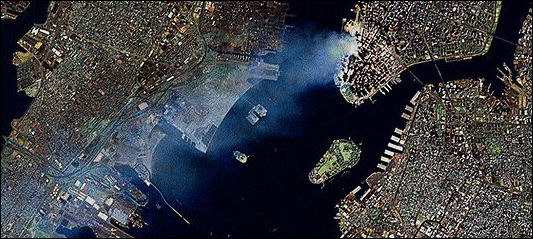
Manhattan on September 12, from Landsat 7
Image Sources: Wikimedia Commons
Text Sources: New York Times, Washington Post, Los Angeles Times, Times of London, The Guardian, National Geographic, The New Yorker, Time, Newsweek, Reuters, AP, AFP, Wall Street Journal, The Atlantic Monthly, The Economist, Global Viewpoint (Christian Science Monitor), Foreign Policy, Wikipedia, BBC, CNN, NBC News, Fox News and various books and other publications.
Last updated July 2012
